キーワード: クォーク・グルーオン・プラズマ、高エネルギー原子核衝突重イオン
http://utkhii.px.tsukuba.ac.jp/
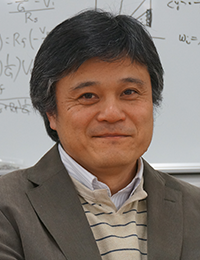 高エネルギーの重イオン衝突実験を行い高温・高密度の宇宙初期の状態を再現し、全ての物質の構成要素がバラバラに飛び交うクォーク・グルーオン・プラズマ(QGP)状態を国際共同チームで探求します。
高エネルギーの重イオン衝突実験を行い高温・高密度の宇宙初期の状態を再現し、全ての物質の構成要素がバラバラに飛び交うクォーク・グルーオン・プラズマ(QGP)状態を国際共同チームで探求します。
地上で宇宙初期の超高温や中性子星内部の超高圧を再現
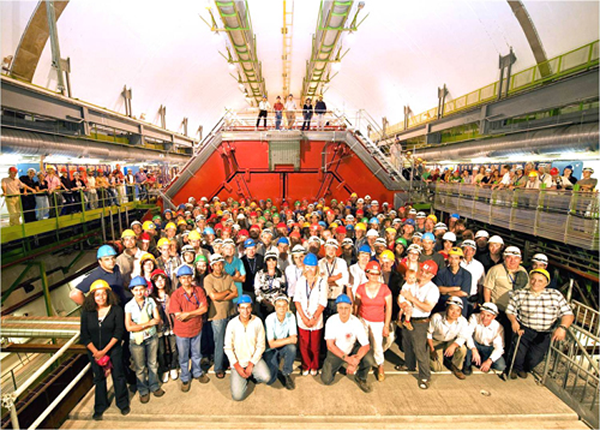
図1:CERN 研究所のALICE 検出器の前で共同実験研究者の集合写真
膨張し冷え続ける宇宙(現在マイナス270℃)は、時を遡れば次第に高温となり宇宙初期は超高温です。その時モノはどんな様子でしょう? 全てのモノは水素や鉄など「原子」から出来ていると習ったのを覚えていますか。どの原子も幾つかの陽子と中性子が結合した原子核とその周りを回る電子から成ります。高温で原子核と電子がバラバラになった「プラズマ」は蛍光灯の内部や太陽内部の状態です。もっと高温では、原子核を構成する陽子・中性子もバラバラになります。実は陽子・中性子はクォークとそれを繋げるグルーオンという素粒子から成ります。そして、超高温でクォークとグルーオンがバラバラ飛び回るようになったスープがクォーク・グルーオン・プラズマ(QGP)です。密度が太陽の100 兆倍の中性子星の内部にもQGP ができています。米国のブルックヘブン国立研究所(BNL)と欧州のCERN にある巨大な装置で原子核を超高速で衝突させるとQGP 状態が地上で再現します。研究により、この不思議な状態QGPも水が蒸気に変わるような「相転移」の結果であることまでがわかってきました。
究極の国際的ビッグサイエンス
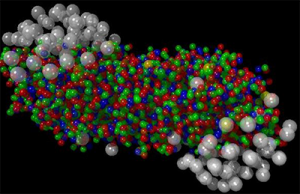
図2:原子核・原子核の衝突シミュレーションの様子(UrQMD 計算より)
米国と欧州の巨大装置を世界中の研究者が共同で使います。実験に必要な技術の種類も多数で、一つの研究グループが最大1−2千人にのぼります。米国・欧州・日本を結ぶTV 会議が四六時中行われます。インターネットの進歩で議論やデータ解析は世界どこででもできますが、新しい装置の取り付け、動作チェックのためには、プロの研究者だけでなく大学院生も数ヶ月間欧州や米国に滞在します。人類共通の科学的謎に挑む究極的文化活動です。
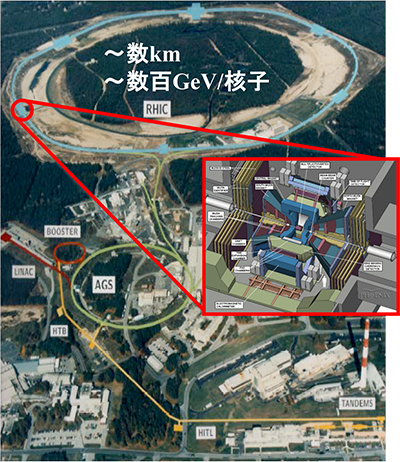
図3:BNL 研究所のRHIC 加速器とPHENIX 実験の検出器
社会への貢献・実績
● つくばグローバルサイエンスウイーク2014(国際会議)にて宇宙進化・物質起源セッション開催
● スーパーサイエンスハイスクール「茗渓学園高校」の生徒のCERN 訪問(H25・H26 夏)
取材:平成27年1月14日
Exploration of the State of Matter in the Early Phase of the Universe by the World United Team
Unit name: Quark Gluon Plasma
Key words: quark-gluon plasma, high energy atomic nucleus, collision-produced heavy ion
 Experiments on the collision of high energy heavy ions are carried out, to reproduce the early phase of the universe characterized by high temperature and high density and to explore the state of quark-gluon plasma (QGP) in which the elemental components of all materials fly in an uncoordinated fashion. Such research will be done by a world united team.
Experiments on the collision of high energy heavy ions are carried out, to reproduce the early phase of the universe characterized by high temperature and high density and to explore the state of quark-gluon plasma (QGP) in which the elemental components of all materials fly in an uncoordinated fashion. Such research will be done by a world united team.
Reproduction of ultrahigh temperature of the early universe and ultrahigh pressure inside neutron stars on the earth

Fig. 1: Researchers involved in cooperative experiments gathering in front of the ALICE Detector at CERN
Although the universe is now expanding and becoming cooler (current temperature = -270°C), the temperature of space was higher in the past (ultrahigh during the early phase of space). Which form was assumed by materials at those times? Do you remember learning at school that every material is made of “atoms” (e.g., hydrogen atoms and iron atoms)? Each atom consists of a nucleus (several protons and neutrons are bound together) and electrons circulating around the nucleus. “Plasma,” the nucleus and the electrons distributed in an uncoordinated manner under high temperature, prevails inside fluorescence lamps and the sun. At further higher temperature, the protons and neutrons constituting the nucleus also become distributed in an uncoordinated manner. To tell the truth, both the proton and the neutron are made of quarks and the elementary particle joining them (“gluon”). The soup consisting of quarks and gluons flying in an uncoordinated manner at ultrahigh temperature is “quark-gluon plasma (QGP).” QGP is present also inside neutron stars whose density is 100 trillion times as high as that of the sun. The state of QGP was reproduced on the globe when collision between atomic nuclei was induced with devices installed at the Brookhaven National Laboratory (BNL), USA and the CERN, Europe, The research conducted to date revealed that this mysterious state “QGP” is an outcome of “phase transition” resembling the change of water into vapor.
Ultimate “global big science”

Fig. 2: Simulation on collision between atomic nuclei (source: UrQMD calculation)
The giant devices installed in the USA and Europe are shared by global researchers. The experiments using these devices require a wide variety of technology, with each research group consisting of one thousand to two thousand members. TV conferences, connecting USA, Europe and Japan, are held at various times of the day. Thanks to recent advances in the Internet, discussions and data analysis related to research on these devices can be done anywhere in the world, but installation of new devices and checking of their motions require on-site work. For this purpose, graduate students, in addition to professional researchers, also visit the European and US facilities mentioned above and stay there for several months. This is an ultimate cultural activity challenging the scientific mystery common for humans.
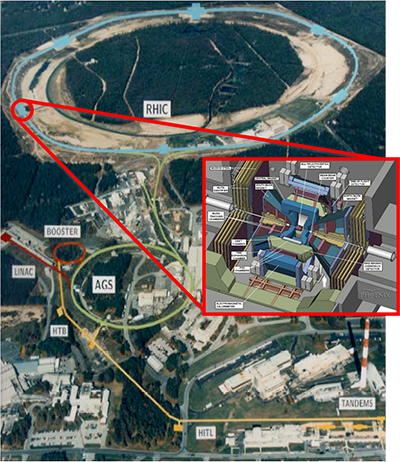
Fig. 3: RHIC accelerator and detector for PHENIX Experiment at BNL
Social contributions and achievements
– A session on space evolution and material origin was held during the Tsukuba Global Science Week 2014.
– Visit to CERN by students of Meikei High School, a super science high school (summer of 2013 and 2014).
Interviewed on January 14, 2015
